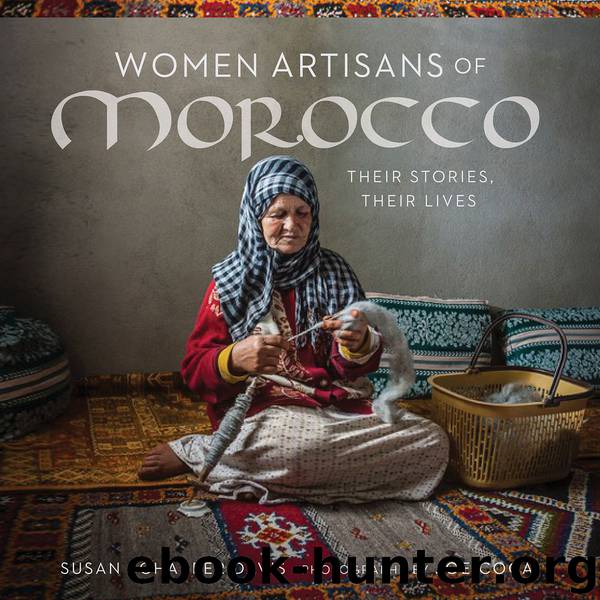Women Artisans of Morocco by Susan Schaefer Davis

Author:Susan Schaefer Davis
Language: eng
Format: epub
Publisher: Thrums Books
Published: 2018-04-19T04:00:00+00:00
Heavy beater to beat the wool.
A traditional flatweave rug, showing the richness of Middle Atlas weaving.
Certain practices shuttle back and forth between old and new ways of doing things. “When I learned to weave with my mother, we didn’t have a special layout in mind. We didn’t say, ‘We’re going to do this or that rug.’ Perhaps we’d borrow a rug from that man who dreams designs and take parts from it. We’d just measure where the center was and work towards it. Since we knew the designs, we’d just let our ideas run free. But after we attended training workshops last year, I started thinking, ‘Before we weave, we should have a plan.’ So we don’t work free-form anymore. Now when we get an order, we make a layout, measure the distance from here to there, and then start weaving. Everyone in our association shares in the overall design of the rug.
“We also wanted to get away from copying the old rugs, with everybody doing the same thing. So now each weaver will do something from her own head. The rugs are black and white in the Beni-Ouarain style, but the motifs in black are all different. Each woman creates her own.”
And so the women have moved from traditional “free-form” weaving to a fixed idea of the final article, obeying certain rules about layout and measurement, and at the same time relying on creative inspiration to weave individual designs.
The founder of Anou wants to encourage creativity in Moroccan artisans, a delicate proposition, and one step in doing so has been to provide a training in it for the four artisan leaders. After this training, Kenza designed and produced a very nontraditional rug.
Despite her interest in the new, Kenza is one of the few women with insight into the cultural significance of traditional designs. One set of symbols, Kenza says, are the letters of the Berber alphabet, which women “hid” in their weaving, which is where researchers found them. While the alphabet may be very old, the use of it is quite recent in Morocco and not very widespread. The letters are neither Western nor Arabic but look a bit like hieroglyphics. Berber or Amazigh speakers are very proud of them. More generally, Kenza says, “The designs are connected to a woman’s life and work. For example, there’s one design that represents a horse’s bridle. It keeps the horse’s mouth closed, it controls. When the design originated, women were dominated. The man was everything. So the design is related to men’s control over women at that time.
“The zigzag design we call the ‘saw’ exists in relation to wood. Like the relationship between saw and wood, we always find the relationship of the man and the woman going along together. Neither could work alone; they help and complete each other.” In contrast to the symbolism of control above, here we see interdependence.
“Nature is the source of our colors: the pastel colors of flowers, the green of the grass, and the blue of the sky.
Download
This site does not store any files on its server. We only index and link to content provided by other sites. Please contact the content providers to delete copyright contents if any and email us, we'll remove relevant links or contents immediately.
1610396766 (N) by Jo Ann Jenkins(1298)
Whatever You Do, Don't Run by Peter Allison(1248)
Botswana--Culture Smart! by Michael Main(1239)
In Arabian Nights by Tahir Shah(1203)
The Old Farmer's Almanac 2020 by Old Farmer’s Almanac(1157)
Livingstone by Tim Jeal(1153)
Ubuntu by Ellis Heather;(1138)
The Templars by Michael Haag(1126)
Dead Eye by Mark Greaney(1111)
Africa: Altered States, Ordinary Miracles by Richard Dowden(1080)
Top 10 Israel and Petra by DK Travel(1073)
Morocco Travel Guide by Lonely Planet(1067)
Egypt Travel Guide by Lonely Planet(1057)
The Promise of a Pencil: How an Ordinary Person Can Create Extraordinary Change by Braun Adam(1055)
False Papers by André Aciman(1053)
First Comes Love, then Comes Malaria by Eve Brown-Waite(1042)
Jeff Corwin by Jeff Corwin(1031)
The Masked Rider by Neil Peart(991)
African Nights by Kuki Gallmann(968)
